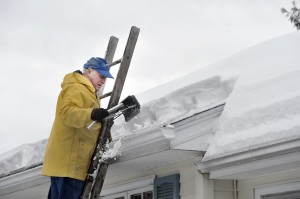
Hilmar Hoppe of Westfield cleans his roof and gutters to prevent ice dams which can damage the interior and exterior of the home. (File photo by Frederick Gore)
WESTFIELD – As greater Westfield recovers from a flash snowstorm earlier this week, followed by a day of warm conditions Thursday, many residents are attempting to rid their properties and roofs of snow to avoid a problem that is afflicting homes all over the northeast.
Ice dams form on the rooftops as a result of water building up behind ice that has gathered. Unable to drain properly, the water sits atop the roof, which can lead to major damage to a home’s interior.
“We’ve dealt with about 20 homes this winter,” said Travis Stopa, owner of Stopa Roofing in Blandford. “It’s definitely been worse than most years. The consistent snowfall and consistent cold weather… we’ve had two big snowstorms, with cold weather in between.”
While Stopa admits this winter hasn’t been as bad as the winter of 2011-2012, he thinks that people are either just becoming aware of what can happen to unattended roofs or are still neglecting their domiciles.
“(In 2011-2012) we got a lot of people calling, saying their roofs, windows and walls were leaking,” he said. “But even now, you still see people with between a foot and two feet of snow on their roofs. And with this warm weather and rain this week, that means a lot more melting, which could lead to pretty serious damage.”
How serious? Stopa says that he has seen sheetrock, insulation and interior damage costing around $10,000 in repairs.
“It all depends how long you let it go,” he said, adding that once you can see brown spots on your walls, “it’s already pretty bad.”
While the snow western Hampden County has seen this week has been mostly of the fluffy, powdery variety, it is exactly that type of precipitation that can exacerbate ice dam conditions.
“With the addition of rain in the immediate forecast, dry, fluffy snow piled on roofs can act as a sponge, absorbing any additional sleet and rain, adding weight and stress to structures if not cleared,” said Massachusetts Emergency Management Agency (MEMA) Director Kurt Schwartz, adding that “flat, commercial roofs are most susceptible if they are not draining properly.”
MEMA also encourages residents to clear their neighborhood storm drains to avoid local flooding as a result of runoff.
The damage from ice dams can also occur on the walls of a home, depending on how long frozen ice sticks to a house’s siding.
“Icicles form when when water runs off the eve of a roof, where there’s a cold space,” Stopa said. “It’ll run until it levels itself off and creates flat spots. When the water has nowhere to go, it finds the point of least resistance, which could be as small as a nail in the side of a house.”
In addition to ice dams, residents should also be aware of the dangers of overstressing their roofs with excessive snow accumulation, which could lead to the collapse of a roof.
MEMA advises residents to be on the alert for large accumulating snow build-up or snowdrifts on roofs, particularly roofs that are flat or only have a slight pitch, as on garages, car ports, or porches.
For residents whose homes have flat roofs, MEMA recommends shoveling them clear if the roof is safe to stand upon, along with making sure that the drainage system of the roof is kept clear to minimize the risk of excess roof ponding.
In addition to keeping up with your roof’s snow removal, MEMA suggests clearing access to fire hydrants and the storm drains on your street to keep run off out of the basements of neighborhood homes.
If you’re already experiencing an ice dam, local roofers say the best bet is definitely not to try fixing it yourself.
“Hire a licensed contractor, someone who knows what they’re doing,” said Lori Liptak, vice president of Liptak Emergency Water Removal. “You don’t want just anyone using a heating coil in your gutters.”
Liptak added that a licensed contractor will use an infrared camera to detect where the water is leaking into your home and, in the event that there is damage, will use anti-microbial remediation to treat any mold or mildew in the home.

